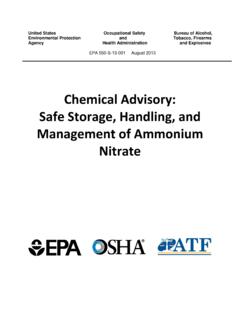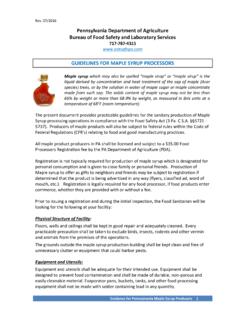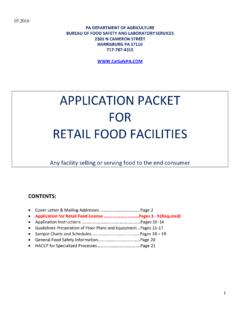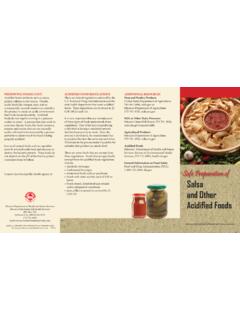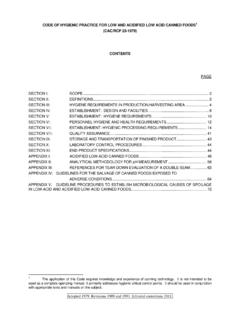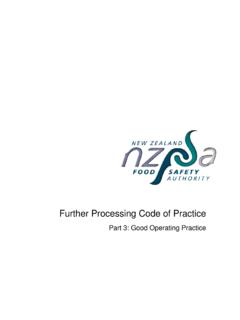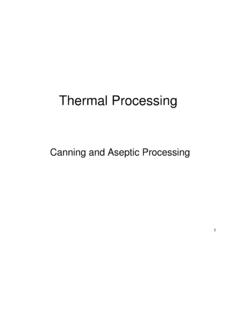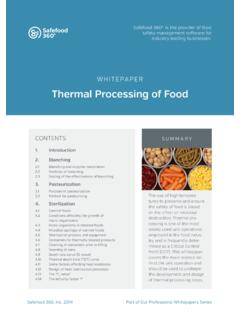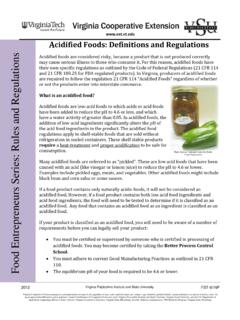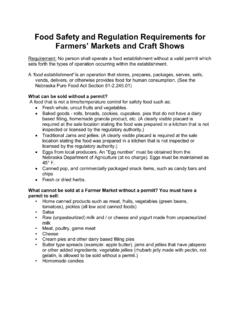Transcription of Canning of Acid, Acidified, or Fermented Foods & Beverages
1 Pennsylvania Department of Agriculture Bureau of food Safety and Laboratory Services 717-787-4315 1 Rev. 12/2017 Canning OF acid , ACIDIFIED, OR Fermented Foods & Beverages -- GUIDANCE FOR PA COMMERCIAL food PROCESSORS -- Canning OF ( acid /ACIDIFIED/ Fermented ) Foods Examples of Types of food products under this category include: Naturally acidic Foods ( most fruits like apples, peaches, lemons, etc.), Fermented Foods ( Korean kimchi, sauerkraut, pickles, green olives, etc.) or, Acidified Foods ( salsa, chow-chow, pickled vegetables, hot sauces, and BBQ sauce). acid Foods are Foods that have a natural pH of or below. Low acid Foods have an equilibrium pH above and water activity above Acidified Foods are defined by the FDA as low- acid Foods to which acid (s) (vinegar or lemon juice) or acid food (s) are added and which have a finished equilibrium pH of or below and a water activity (aw) greater than Producers of Acidified Foods must test their products for pH and Water Activity (aw) and they must have written recipes / formulas and procedures.
2 You will need to provide a Process Flow for your products and have it approved by your food Inspector prior to registration and sale of your product. Processors of Acidified Foods should work with a process authority to develop their scheduled process and determine any critical factors for their product (pH, time/temperature for heat treatment, etc.). A Process Authority is a qualified person who has expert knowledge acquired through appropriate training and experience in the acidification and processing of acidified Foods . Contact your local university extension for a list of process authorities. Processors of acidified Foods offered for interstate commerce are required to register with FDA, file scheduled processes (through their process authorities), and the operation must be under supervision of a qualified individual through education ( Better Process Control School) and/or relevant experience.
3 These requirements should be discussed with FDA. See more information about federal requirements and FDA contact below. 1. Initial Product testing: Initially, the producer shall have each unique recipe/product tested for pH and aw by an independent commercial food laboratory and test results submitted with the application for review. Producers of acidified/ Fermented Foods or Beverages must obtain testing results for equilibrium pH showing that their products fall within safe ranges of pH or below. However, producers of acidified/ Fermented Foods or Beverages should aim for a pH level of or below as an extra precaution. 2. Ongoing product testing and Record keeping o If the final equilibrium pH is or below, you must have either a properly calibrated pH meter or pH test strips to verify your pH of every batch produced. o If the final equilibrium pH is above , you must have a properly calibrated pH meter and check the pH of every batch produced.
4 O If the final equilibrium pH is above , see the low acid canned Foods or Beverages section below. All records pertaining to monitoring pH as the critical process control (pH log sheets) must be kept showing production date, batch number, pH and any corrective actions taken to correct deficiencies noted if pH was or above. Records showing verifications and calibration of the pH meter must also be kept. Pennsylvania Department of Agriculture Bureau of food Safety and Laboratory Services 717-787-4315 2 Rev. 12/2017 How to properly test for equilibrium pH: Equilibrium pH is the final pH in the food product after the acidic brine or ingredient acidifies and balances with the other ingredients. For a proper pH reading, you should test the pH of the product roughly 24 hours after processing, once the containers have cooled to room temperature and stabilized. Do not take the pH of a product just before or right after Canning because it will not be an accurate measure of the equilibrium pH.
5 O If a food is homogeneous, that is of uniform consistency (apple sauce, barbeque sauce, ketchup, etc.), then the pH of any portion may be considered to be representative of the whole. o If the food is semi-solid ( puddings, chunky salsas, and very thick sauces), these Foods should be blended to a uniform paste before testing. If additional liquid is required to blend the samples, use distilled water (20 parts of distilled water/100 parts of food ). o If the food consists of a mixture of liquid/solid Foods ( pickled vegetables, etc.), then you need to pur e this in a blender, with distilled water if necessary, into a slurry. The solid portion may differ in acidity from the covering liquid (brine). Therefore, it is necessary to test both components in order to determine the equilibrium pH. This can be done either by blending fractions of both solid and liquid portions in the same ratio as found in the original container or simply by blending the entire contents of the container to a uniform paste and then test for pH.
6 More information about the use the pH meter and the sample preparation can be found in 21 CFR pH meter purchase guidance: For guidance on how to purchase a pH meter, please visit Cornell University s fact sheet on purchasing a pH meter. Our general pH meter recommendations are if you are producing a food product with a pH of or higher, it is best to purchase a pH meter with an accuracy rating of + pH units. If producing an acidified food with a pH below , it would be best to purchase a pH meter that has an accuracy rating of + pH units. 3. Thermal Process and record keeping All recipes of acidified Foods must incorporate a thermal process (cooking) to ensure its safety and shelf stability by destroying the pathogenic and spoilage microorganisms that might be present in the product. For acidified canned Foods , the safety and shelf stability are achieved by employing one of following methods: a.
7 Hot-fill-hold process the product is cooked and filled at a temperature of 180 F (or above) and a closure or lid is applied (by a steam capper or alternately). The sealed container is inverted and held for 1 minute or longer to ensure pasteurization of the container headspace and inside surfaces. The container is then turned right side up and allowed to air cool. Processors may choose to hold the inversion longer to ensure safety and that a strong seal is achieve on the container. This type of process is mostly used effectively for Foods with smooth consistency ( sauces, salsa, etc.) b. Water bath or steam ( Canning ) process the preheated product is filled into the container and the closure is applied. The container is subjected to hot water bath or steam Canning until the coldest spot in the container reaches at least the minimum required conditions of times and temperatures for safety*.
8 *Scientific studies were conducted and provide recommendation on the minimum processing time/ temperature combinations to achieve a 5-log reduction in bacterial pathogens for acidified products. Pennsylvania Department of Agriculture Bureau of food Safety and Laboratory Services 717-787-4315 3 Rev. 12/2017 For acidified Foods with an equilibrium pH of or below: (partial table, see full table here) Temp.( F) Time (min.) Temp.( F) Time (min.) Temp.( F) Time (min.) Temp.( F) Time (min.) 159 162 166 171-173 160 163 167-168 174-177 161 164-165 169-170 178-181 Reference: food Protection Trends: p268-272 For acidified Foods with an equilibrium pH of (partial table, see full table here) Temp.( F) Time (min.) Temp.( F) Time (min.) Temp.( F) Time (min.) Temp.( F) Time (min.) 154 160 165 170 156 162 167 175 158 164 169 179-180 Reference: food Protection Trends: p132-138.
9 It is important to note that the recommended time-temperature processing conditions above are the minimum required at the coldest spot in the container; it is the type of food , food properties and type/size of the container that will dictate the final processing conditions, thus a thermal process must be established and approved. c. If the Acidified food does not allow for a heat treatment ( oil based formulation, emulsions, etc.), an alternative process where safety can be assured without a heat process may be employed if the following conditions are met: Final pH is adjusted to or below. Acetic acid ( vinegar) is used as the primary acidulant and/or benzoic acid is added as a preservative. Product must be held at 77 F or higher for a minimum of 48 hours prior to distribution. It is the combination of the specific killing effect of acetic acid , benzoic acid , low pH and hold temperature and time that ensures safety.
10 All records pertaining to monitoring of the thermal process ( time, temperature) must be kept for each batch produced as well as records of verifications (thermometer calibration, etc.) and corrective actions taken to correct deficiencies noted on the process records. 4. Other requirements for Canning : o Anytime a recipe is altered or a new recipe is developed, the final product must be tested and approved as described above. o Use only clean and sanitary equipment/ utensils and adhere to good manufacturing and personal hygiene practices (to prevent cross-contamination and allergen cross-contact). o Use only new lids. Re-used jars may be allowed but they must be thoroughly washed and sanitized. o All labeling requirements on the containers must be met. Pennsylvania Department of Agriculture Bureau of food Safety and Laboratory Services 717-787-4315 4 Rev. 12/2017 LOW acid canned Foods OR Beverages Generally, any food /beverage with a finished equilibrium pH greater than and a water activity greater than , is considered a low- acid food .




